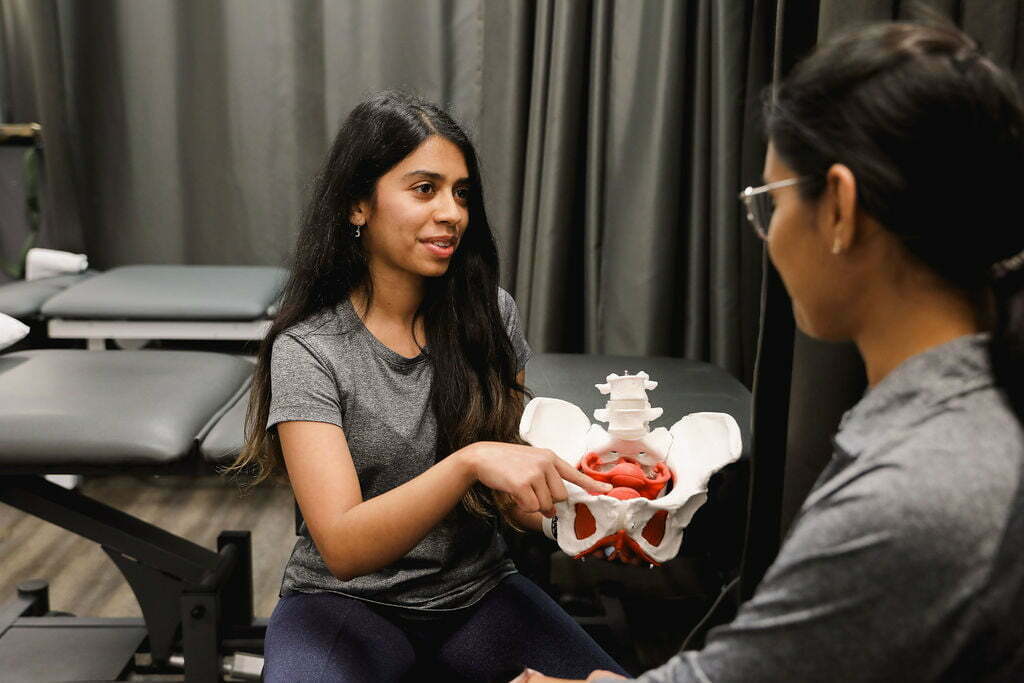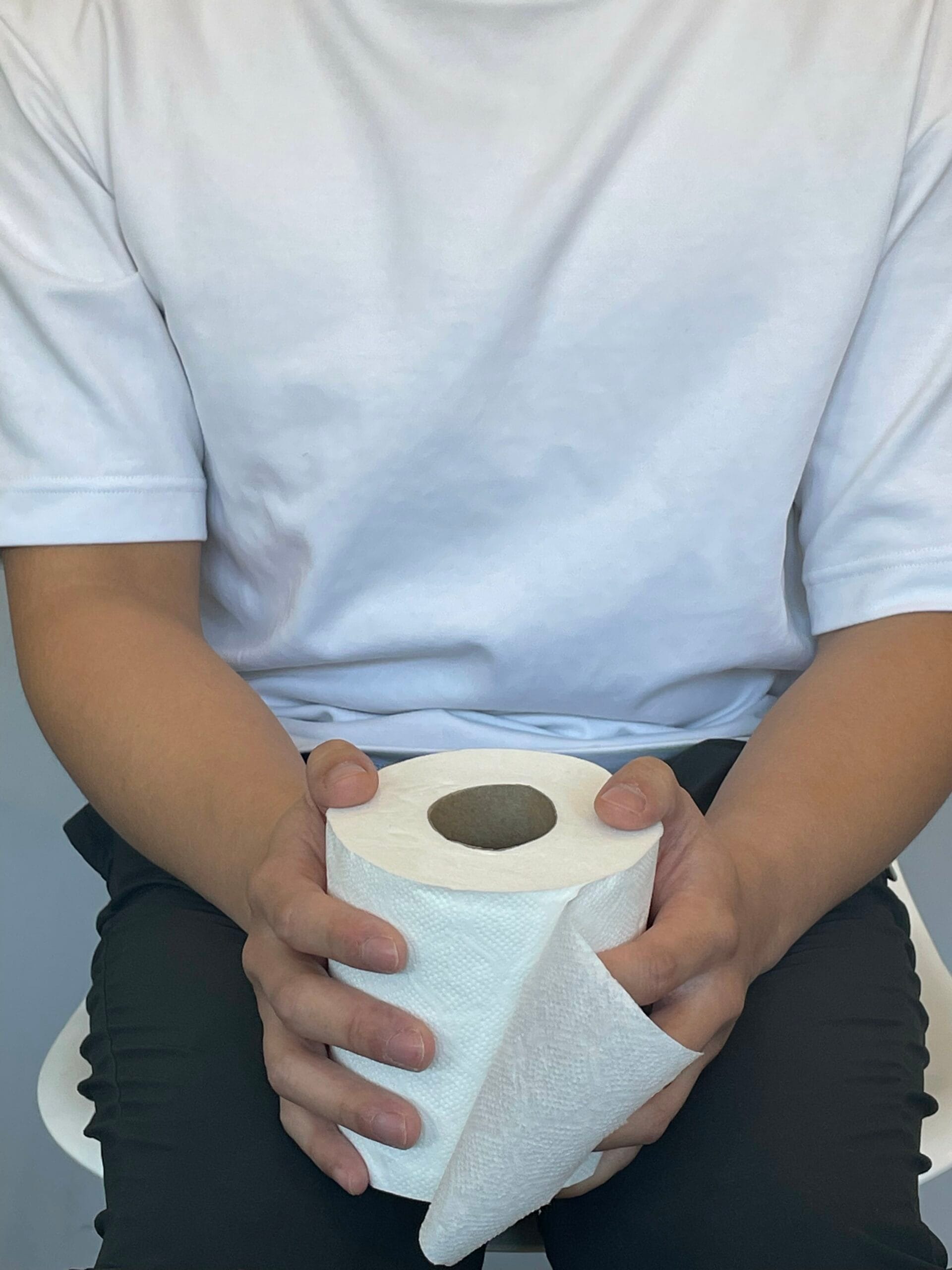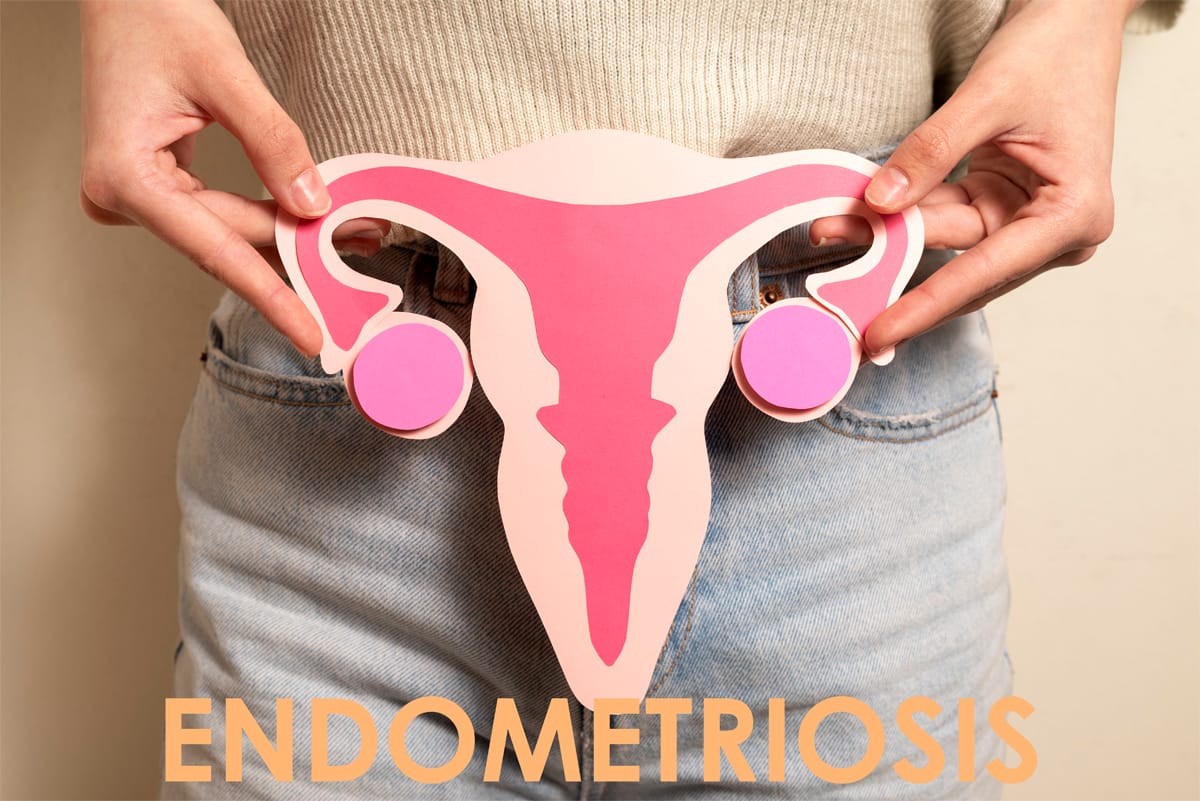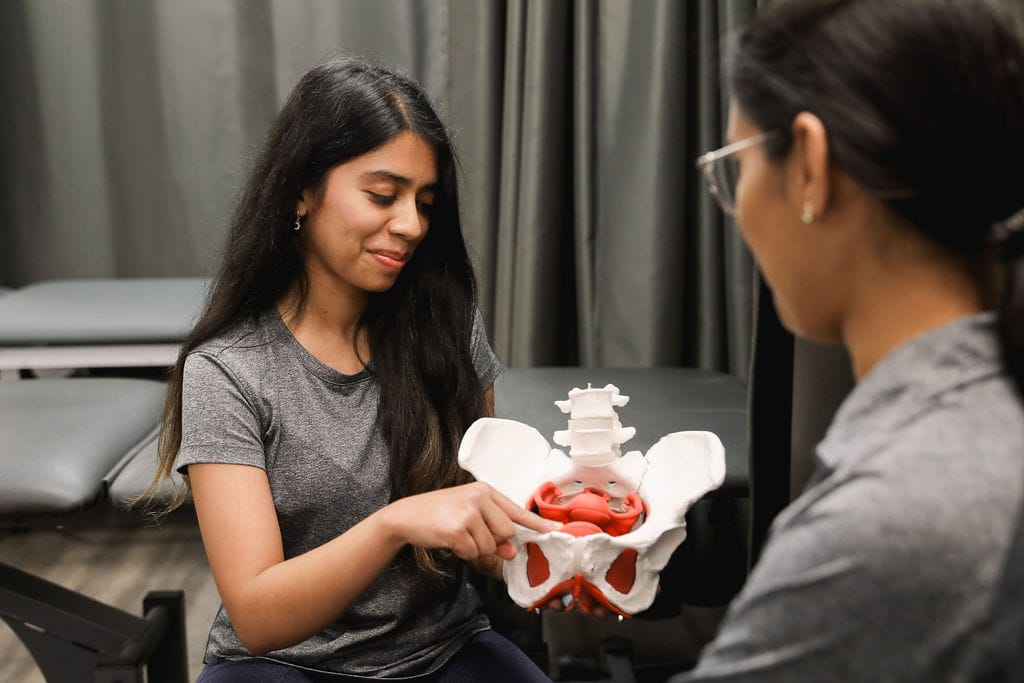Pelvic organ prolapse (POP) is a condition in which there is a descent of the pelvic organs into or through the vaginal or anal canal. This can present as:
- a visible bulge in the above openings,
- pressure felt in the pelvic area,
- incomplete emptying of bladder or bowels,
- discomfort during intercourse.
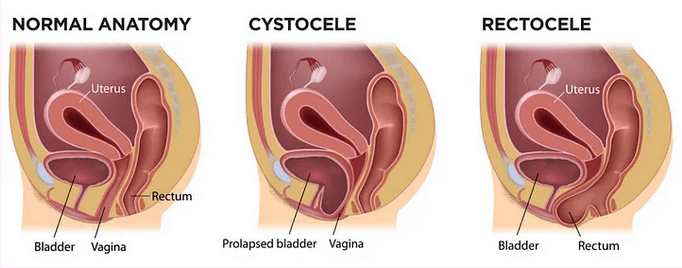
The main reason for prolapse is increased pressure on the pelvic floor due to:
– Chronic constipation
– Bearing children
– Pelvic floor weakness due to hormonal imbalance
Conservative non-surgical management is the first line of treatment for POP.
Your pelvic floor physiotherapist will assess the severity of your symptoms, the strength of your pelvic floor and your ability to manage pressure and stresses to your pelvic floor. Treatment would include strengthening exercises for the core and pelvic floor muscles and coordination techniques for all the inner unit muscles.
The types of pelvic organ prolapse are:
- Anterior Wall Prolapse
- Posterior Wall Prolapse
- Rectal Prolapse
Depending on the grade and type of prolapse, you might be a candidate for a pessary fitting.
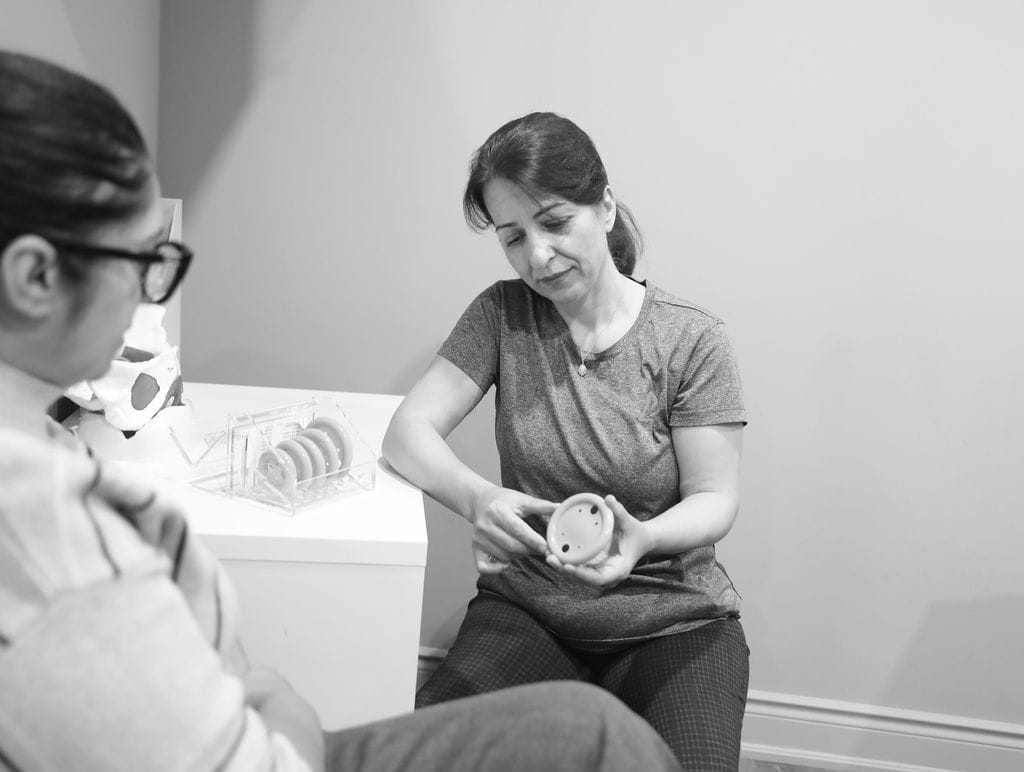
A pessary is a medical grade silicone device that is inserted into the vaginal canal in order to support the vaginal walls. If you are a candidate for a pessary, it must be fitted for you by a trained professional such as gynaecologists, nurses that have a certification in fittings or pelvic health physios that are specialized to do so.
We currently have 3 practitioners at Triangle Physiotherapy who are certified in pessary fittings.
Your pelvic floor deserves more than just kegels. Speak to a pelvic health physiotherapist today to get started!
Where can I find a pelvic health physiotherapist near me?
We have 8 locations with pelvic health physiotherapists to help you.
- Pelvic Health Physiotherapy Etobicoke – Triangle Physiotherapy Etobicoke
- Oakville Pelvic Health – Triangle Physiotherapy Oakville
- Pelvic Health Physiotherapy North York – Triangle Physiotherapy North York
- Mississauga Pelvic Health – Triangle Physiotherapy Mississauga
- Downtown Pelvic Health – Triangle Physiotherapy King West
- Uptown Toronto Pelvic Health – Triangle Physiotherapy Lawrence Park
- Pelvic Physiotherapy Downtown Toronto – Triangle Physiotherapy Queens Quay
- Mississauga Pelvic Health – Triangle Physiotherapy Erin Mills
Written by Roshni Ravi, Pelvic Health Physiotherapist
Have you ever experienced pain with sex? A burning sensation during or afterwards, a sharp pain or general discomfort? A lot of these symptoms point towards a common condition called dyspareunia. This is also known as pain with intercourse. It is a common condition postpartum, during menopause or even just due to general pelvic floor dysfunction.
But don’t worry, there are ways to alleviate the discomfort and enjoy a fulfilling sex life again! One of the most effective methods is through pelvic health physiotherapy.
Pelvic health physiotherapy involves working with a trained professional to strengthen and stretch the muscles in your pelvic floor, which can become weakened or tight due to a variety of factors. By doing so, you can improve your pelvic floor function and reduce pain during sex.
When it comes to sexual dysfunction, pelvic physiotherapy can be an effective treatment option for women. Pelvic physiotherapy can help address issues such as pain during intercourse, difficulty achieving orgasm, or vaginismus (involuntary contraction of the vaginal muscles).
What does a treatment session entail?
During a pelvic physiotherapy session, you’ll typically undergo an initial evaluation where your therapist will assess your pelvic floor muscles and create a personalized treatment plan. The exercises and techniques used will vary depending on your specific needs and goals, but they may include:

- Pelvic floor relaxation exercises
- Deep breathing
- Yoga based therapy
- Functional strengthening such as squats
- Biofeedback and/or muscle stimulation
It’s important to note that pelvic physiotherapy isn’t a quick fix and may take several sessions to see results. However, with dedication and commitment, it can significantly improve your quality of life and sexual function. So if you’re experiencing dyspareunia, don’t suffer in silence. Talk to your healthcare provider about pelvic physiotherapy and take the first step towards a happier, healthier you.
Book your consultation with a pelvic health physiotherapist today. We have pelvic health physiotherapists at all eight of our locations.
Where can I find a pelvic health physiotherapist near me?
We have 8 locations with pelvic health physiotherapists to help you.
- Pelvic Health Physiotherapy Etobicoke – Triangle Physiotherapy Etobicoke
- Oakville Pelvic Health – Triangle Physiotherapy Oakville
- Pelvic Health Physiotherapy North York – Triangle Physiotherapy North York
- Mississauga Pelvic Health – Triangle Physiotherapy Mississauga
- Downtown Pelvic Health – Triangle Physiotherapy King West
- Uptown Toronto Pelvic Health – Triangle Physiotherapy Lawrence Park
- Pelvic Physiotherapy Downtown Toronto – Triangle Physiotherapy Queens Quay
- Mississauga Pelvic Health – Triangle Physiotherapy Erin
“Revitalizing your relationship and reclaiming your sex life can be achieved with the help of pelvic floor physiotherapy. Triangle Physiotherapy offers specialized services across the GTA, including Physiotherapy in Etobicoke, Oakville, North York, Toronto, Lawrence Park, Queens Quay, Erin Mills, Mississauga, and Liberty Village. Our experienced team can help you address pelvic floor issues and enhance intimacy through personalized treatment plans.”
Written by Roshni Ravi, Pelvic Health Physiotherapist
Stress incontinence is a type of urinary incontinence that occurs with physical activity or exertion. This can be from coughing, sneezing, laughing or exercise e.g. jumping. All of these actions can put pressure on the bladder thereby causing leaks. The pelvic floor is important in preventing this leaks and supporting the bladder.
Pelvic floor exercises such as a kegel are commonly recommended for leaks. However, a lot of time the pelvic floor is actually tight rather than weak. Reverse Kegels involve relaxing the pelvic floor muscles, allowing them to lengthen and release tension. This helps to prevent over-tightening and over-activity of the pelvic floor muscles, which can contribute to stress incontinence.

Hypertonic pelvic floor
Hypertonic pelvic floor refers to a condition where the pelvic floor muscles are in a state of excessive and persistent contraction. This can lead to a number of symptoms, including pelvic pain, urinary and fecal incontinence, and sexual dysfunction.
Hypertonic pelvic floor can be caused by a number of factors, including pregnancy, childbirth, surgery, chronic constipation, and chronic pelvic pain. It can also be a result of excessive or improper use of pelvic floor muscle exercises, such as Kegels.
Treatment for Hypertonic pelvic floor
Treatment for hypertonic pelvic floor typically involves a combination of physical therapy and relaxation techniques. Physical therapy may include manual therapy to release muscle tension, as well as exercises to stretch and relax the pelvic floor muscles. Relaxation techniques, such as deep breathing, progressive muscle relaxation, and biofeedback, can also be helpful in reducing muscle tension.
If you’re experiencing leaks, reach out to a pelvic floor therapist for an assessment or discovery call!
FAQ’s about Stress Incontinence
Q: What is stress incontinence?
A: Stress incontinence is a type of urinary incontinence that occurs when pressure is placed on the bladder, such as during coughing, sneezing, laughing, or exercising, and causes involuntary urine leakage.
Q: What causes stress incontinence?
A: Stress incontinence is typically caused by weakened pelvic floor muscles and/or a weakened urethral sphincter, which can occur due to aging, pregnancy and childbirth, menopause, obesity, chronic coughing, or certain medical conditions.
Q: Who is at risk for developing stress incontinence?
A: Women are more likely to develop stress incontinence than men, especially those who have gone through pregnancy and childbirth, menopause, or pelvic surgery. Other risk factors include obesity, chronic coughing, and certain medical conditions that affect the bladder or nervous system.
Q: How is stress incontinence diagnosed?
A: Stress incontinence can be diagnosed through a physical exam, a urine test, and other tests such as a bladder diary or urodynamic testing.
Q: What are the treatment options for stress incontinence?
A: Treatment options for stress incontinence may include:
- pelvic floor exercises,
- behavioral therapies,
- medications,
- medical devices such as pessaries, and in some cases,
- surgery.
Q: Can stress incontinence be prevented?
A: While stress incontinence may not be completely preventable, there are steps you can take to reduce your risk. Maintaining a healthy weight, doing regular pelvic floor exercises, and avoiding smoking and excessive caffeine consumption are some of these.
Q: Is stress incontinence a normal part of aging?
A: While stress incontinence is more common in older adults, it is not a normal part of aging and should not be ignored or accepted as an inevitable consequence of getting older. Treatment options are available, and seeking help from a healthcare provider is important.
Managing stress incontinence effectively involves a combination of pelvic floor exercises, lifestyle changes, and sometimes physiotherapy. For those seeking professional physiotherapy services to help manage incontinence and improve pelvic health, there are clinics in physiotherapy Etobicoke, Oakville, North York, Toronto, Lawrence Park, Queens Quay, Erin Mills, Mississauga, and Liberty Village. These clinics offer expert care and personalized treatment plans to help you achieve a leak-free life and enhanced quality of life.
Written by Roshni Ravi, Pelvic Health Physiotherapist
Constipation is a common gastrointestinal (GI) condition that causes difficulty with passing stool or reduces the frequency of having a bowel movement. It can be caused by
– dehydration
– diet e.g. not enough fibre
– sedentary lifestyle
– Ignoring the urge for a bowel movement due to pain.
– Pelvic organ prolapse (POP)
– Medications such as anti-inflammatories, iron supplements or anti depressants.

Medically, constipation is defined as having fewer than 3 bowel movements a week with hard stools.
Pelvic muscle dyssynergia (incoordination) can lead to constipation. During a typical bowel movement, the pelvic floor needs to relax in order to evacuate stool. When there is tightness in the pelvic floor muscles, it can be painful or uncomfortable to pass stool.
Treatment for constipation can include a number of lifestyle modifications such as increased fibre and water intake, and regular exercise. However, consulting with a pelvic physiotherapist can improve outcomes, by creating an exercise program specific to your pelvic floor dysfunction. The need for lengthening versus strengthening of the pelvic floor is determined through internal vaginal or rectal examination. Another option is seeing a naturopath for ways to adjust your diet accordingly. Quite often, both treatments go hand in hand.
Experiencing constipation or constipation like symptoms? Book a consultation with one of our pelvic physiotherapists today!
“Pelvic physiotherapy can be an effective solution for relieving constipation and improving overall pelvic health. Triangle Physiotherapy offers specialized services across the GTA, including Physiotherapy in Etobicoke, Oakville, North York, Toronto, Lawrence Park, Queens Quay, Erin Mills, Mississauga, and Liberty Village. Our experienced team can help you develop a personalized treatment plan to address constipation and enhance your quality of life.”
The labour and delivery process can greatly benefit from Pelvic Physiotherapy. Pelvic Physiotherapists can help to improve strength and mobility of the muscles and joints in the pelvic area and help make it easier for the baby to descend through the birth canal during delivery.
FAQs about the Labour and Delivery Process
What are the different stages of Labour and Delivery?
The three stages of labour and delivery are:
- Early Labour: This is from the onset of labor to when the cervix is fully dilated to 3-4 centimeters.
- Active Labour: This is when the cervix is fully dilated to 3-4 centimeters to when it is fully dilated to 10 centimeters.
- Transition: This is when the cervix is fully dilated to 10 centimeters to the delivery of the baby.
How long does labour usually last?
The duration of labour varies from person to person and can range from a few hours to over 24 hours for first-time mothers.
What are the common signs of labour?
The common signs of labour include:
- Regular contractions
- Water breaking
- Back pain
- Pelvic pressure
- Blood-tinged mucus discharge
What is an epidural and how does it work?
An epidural is a type of anesthesia that is used to relieve pain during labor and delivery. It is administered through a small catheter placed in the lower back and works by blocking the sensation of pain in the lower body while allowing the woman to remain conscious.
What is the process of a vaginal delivery like?
A vaginal delivery is the delivery of a baby through the birth canal without the use of surgical intervention. During a vaginal delivery, the baby moves through the birth canal and the mother pushes with contractions to help deliver the baby.
What is a cesarean delivery (C-section)?
Doctors perform a cesarean delivery (C-section) by making an incision in the mother’s abdomen and uterus to deliver the baby. They typically opt for a C-section when a vaginal delivery is not possible or when there is a medical concern for the mother or the baby.
What are some of the risks associated with labour and delivery?
Some of the risks associated with labor and delivery include:
- Preterm labour and delivery
- Hemorrhage
- Infection
- Fetal distress
- Shoulder dystocia (difficulty delivering the baby’s shoulders)
What can I do to prepare for labour and delivery?
You can prepare for labour and delivery by:
- Take childbirth education classes
- See a pelvic health physiotherapist
- Create a birth plan
- Find a supportive birth team like doulas or midwives
- Pack a hospital bag
- Discuss pain management options with your healthcare provider.
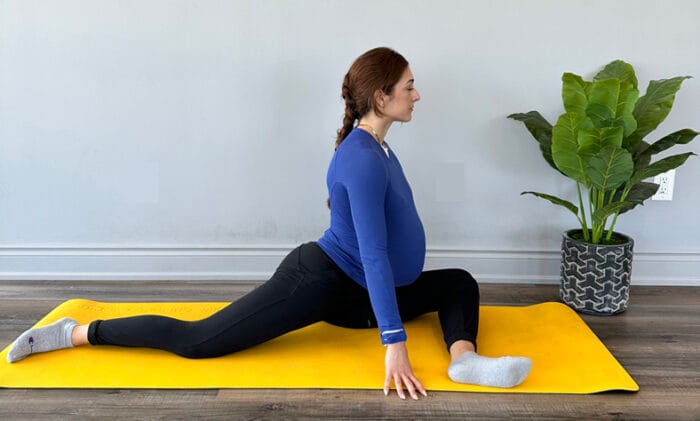
The role of Pelvic Health Physiotherapists in preparing you for Labour and Delivery

Pelvic physiotherapy can help to alleviate common pregnancy-related symptoms such as back pain, incontinence, and pelvic pain. A combination of manual therapy techniques with soft tissue and joint mobilization along with mobility work can be used to alleviate pain in the pelvic area, additionally, the physiotherapist can also work on alignment and posture to help prevent injury and reduce discomfort.
Leading up to labour, a pelvic physiotherapist can provide you with a variety of tools to help with pain relief and positioning to improve your experience during labour. One of the common techniques taught to birthing parents at 32 weeks, is the perineal massage to reduce the chance of tearing during delivery. In addition, you would also be taught positions to help reduce discomfort during contractions as well as pushing techniques.
After delivery, a physiotherapist can help restore strength and mobility along with providing education on suitable abdominal and pelvic floor exercises based on weaknesses and tone, moreover, any side effects from delivery such as perineal tearing can also be treated post-partum.
Have questions? Discuss your options with a pelvic health physiotherapist for pregnancy and post-partum care!
How do I find a pelvic health physiotherapist near me?
We have 8 locations with pelvic health physiotherapists to help you.
- Pelvic Health Physiotherapy Etobicoke – Triangle Physiotherapy Etobicoke
- Oakville Pelvic Health – Triangle Physiotherapy Oakville
- Pelvic Health Physiotherapy North York – Triangle Physiotherapy North York
- Mississauga Pelvic Health – Triangle Physiotherapy Mississauga
- Downtown Pelvic Health – Triangle Physiotherapy King West
- Uptown Toronto Pelvic Health – Triangle Physiotherapy Lawrence Park
- Pelvic Physiotherapy Downtown Toronto – Triangle Physiotherapy Queens Quay
- Mississauga Pelvic Health – Triangle Physiotherapy Erin Mills
The journey through labor and delivery can be significantly supported with proper physiotherapy, which helps prepare the body for childbirth and aids in postpartum recovery. If you are looking for professional physiotherapy services to support your pregnancy and postpartum needs, consider clinics in physiotherapy Etobicoke, Oakville, North York, Toronto, Lawrence Park, Queens Quay, Erin Mills, Mississauga, and Liberty Village. These clinics offer expert care and personalized treatment plans to help you through every stage of pregnancy and beyond.
By Roshni Ravi, Pelvic Health Physiotherapist
Endometriosis is a condition in which the tissue that lines the uterus grows outside of it, on other organs or structures in the pelvic cavity. This tissue, called endometrium, acts just like the lining of the uterus and thickens, breaks down, and bleeds with each menstrual cycle. However, because this tissue is located outside of the uterus, it has no way to exit the body, which can lead to pain, heavy bleeding, and the formation of scar tissue and adhesions. Endometriosis can also affect fertility.
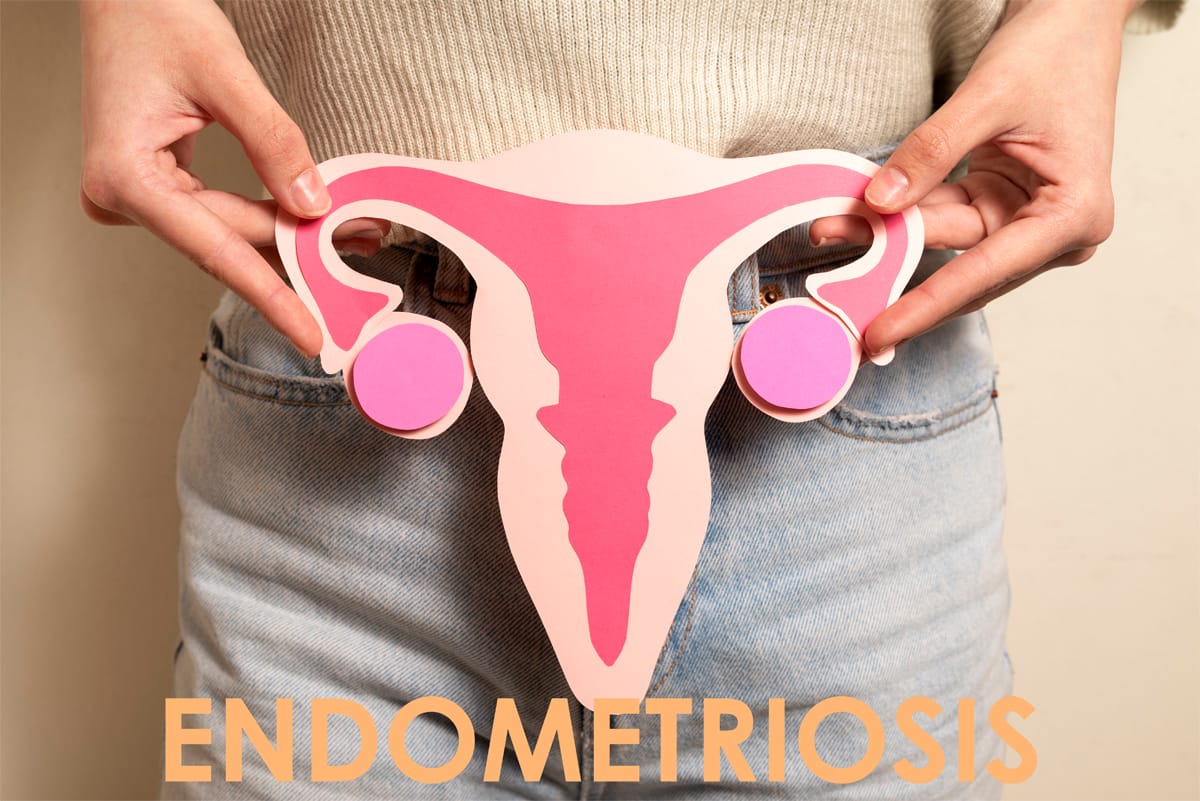
What is Endometriosis?
The cause of endometriosis is not well understood. It is usually treated with hormones, pain medication, and surgery. The average delay from symptom onset to diagnosis is 5.4 years in Canada, because of the uncertain etiology. Patients wait for an average of 3.1 years from the onset of symptoms to seeking consultation with their physician.
Some causes for endometriosis may possibly include:
- Retrograde menstruation: some of the endometrial tissue flows backwards through the Fallopian tubes and into the pelvic cavity, and attaches to other organs and structures.
- Embryonic cell growth: develops from cells in the embryonic stage that grow into endometrial tissue instead of into other tissue types
- Immune system dysfunction: some women may have a dysfunction in their immune system that allows endometrial tissue to grow outside the uterus
- Hormonal factors: hormonal imbalances contribute to the development of endometriosis
- Genetic factors
So what can I do about it?
Medical treatment includes surgery, hormonal therapy and medicated pain management. Other alternatives are acupuncture, herbal supplements and pelvic floor physiotherapy.
Pelvic floor physiotherapy can be beneficial for endometriosis. It can help alleviate pain, improve mobility and flexibility as well as reduce the formation of adhesions and scar tissue. Treatment targets the muscles and soft tissue in the pelvic area through techniques such as manual therapy, trigger point release and myofascial release to relax the muscles and thereby alleviate pain. There are a variety of pelvic floor exercises that can also contribute towards alleviating pain and improving symptoms.
Unsure of what to do next but experiencing these symptoms? Consult a pelvic health physiotherapist to see if pelvic floor physiotherapy is right for you. Our Mississauga Pelvic Health Physiotherapists are experienced and qualified to help you through this diagnosis. Book an appointment here.
Disclaimer: This article is for informational purposes only and should not be used for self-diagnosis.
“Recognizing the early signs of endometriosis is crucial for effective management and care. Triangle Physiotherapy offers expert pelvic health services across the GTA, including Physiotherapy in Etobicoke, Oakville, North York, Toronto, Lawrence Park, Queens Quay, Erin Mills, Mississauga, and Liberty Village. Our experienced physiotherapists provide personalized treatment plans to help you manage endometriosis symptoms and improve your quality of life.”
Did you know children can benefit from pelvic physiotherapy too?
Most children are dry at night by school age. Approximately, 30% of children wet the bed at 4 ½ years of age. Fecal incontinence is also common in children. If a child has regular soiling or poo accidents after the age of 4 they should be assessed.
There is no cause to worry. Pelvic Health issues in children can be resolved with the help of a trained pelvic health physiotherapist at Triangle Physiotherapy.
Common conditions experienced by children include:
Constipation: infrequent bowel movements, frequent movements with pain or difficulty
Incontinence: inability to maintain bowel or bladder function. Could be inability to make it to the bathroom in time or leakage with giggles and coughing
Bed Wetting (Enuresis): leaking urine through the night while sleeping.
Voiding issues (eg. Dysfunctional voiding & postponement): inappropriately engaging pelvic floor muscles during voiding or delaying going to the bathroom, sometimes as a result of fear or pain.
Did you know 85% of children have bed wetting or fecal incontinence because of constipation?

If your child is 5 or older and experiencing any of the above symptoms pediatric Pelvic Floor Physiotherapy can help them get back to being kids, and relieve familial stress!
Our trained therapists create a personalized treatment plan with parents and children to better target your concerns and furthermore improve your child’s overall quality of life. Treatment is always in a way that is fun and engaging for your young one.
What does a pelvic floor assessment entail?
Your physical therapist will start by taking a detailed child developmental and family history. We may also ask you to complete a bladder diary to better track your child’s voiding patterns and perform a functional assessment of their breathing. Thereafter, the physiotherapist will do a visual assessment for which the child need not undress. Sometimes, the physiotherapist will use externally placed sensors to assess the functioning of the pelvic floor muscles.
Note: An internal assessment is not performed.
What does the pelvic floor treatment entail?
- Education dietary foods/irritants, habit training, digestion, pelvic floor anatomy
- Biofeedback machines using Bluetooth to keep children engaged playing games with the aid of their pelvic floor muscles.
- Electrical Stimulation
- Toilet training
- Massage
Which locations of Triangle Physiotherapy offer Pediatric Pelvic Health in Toronto?
Pediatric Pelvic Floor Physiotherapy is offered at Triangle Physiotherapy North York, Triangle Physiotherapy Mississauga and Triangle Physiotherapy Lawrence Park.
Click here to book an appointment for your child.
Pediatric pelvic floor physiotherapy is essential for addressing bladder and bowel control issues in children. Triangle Physiotherapy offers specialized services across the GTA, including Physiotherapy in Etobicoke, Oakville, North York, Toronto, Lawrence Park, Queens Quay, Erin Mills, Mississauga, and Liberty Village. Our experienced team provides personalized care to help young patients overcome these challenges and improve their quality of life.
Pelvic floor physiotherapy is a specialized form of physical therapy that focuses on the muscles, ligaments, and connective tissues of the pelvic floor. While both men and women have a pelvic floor, this form of therapy is particularly relevant for women due to specific concerns related to pregnancy, childbirth, and menopause.
Did you know:
- 1 in 5 women who have had a baby suffer from poor bladder and bowel control
- 1 in 2 experience pelvic organ prolapse
- 1 in 5 women suffer from pelvic or sexual pain
- Most physical activity will engage your Pelvic Floor Muscles
Also read, Physiotherapy Clinic in Etobicoke
Pelvic Floor Muscles
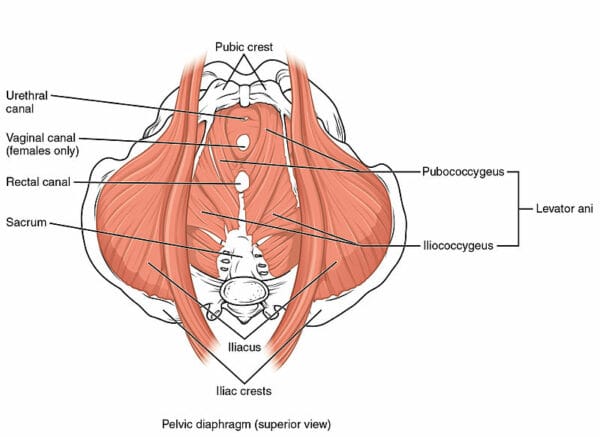
In order to better understand what happens in muscular dysfunction, it is important to first understand the normal function of these muscles, as well as other muscles that they work with. The Pelvic Floor Muscles are part of a group of muscles that are collectively referred to as your “core” muscles. This muscle group is composed of 4 distinct but linked group of muscles:
- Pelvic Floor Muscles
- Diaphragm
- Abdominal Muscles
- Lower Back Muscles
Also read, Physiotherapy Oakville
The Pelvic Floor muscle group is located at the base of the core. It is an important muscle group that works with the rest of the core to maintain pressure inside the torso when lifting heavy objects, coughing/sneezing or doing any other physical activity involving your lower back muscles. Some of the most important functions of the Pelvic Floor Muscles are:
- Maintaining control of the bowel and bladder in order to control leakage
- Holding up and supporting the bowel, bladder, and in the case of women, the uterus
- Playing an important role in sexual function
Pelvic Floor Muscles are located within the pelvic cavity and attach from the front to the pubic bone to the back to your tailbone or coccyx.
Also read, Physiotherapy treatment Mississauga
Pelvic Floor Dysfunctions in Women
For women, the Pelvic Floor holds additional importance as it is the group of muscles that handles enormous pressure during pregnancy. The ever-increasing weight of a child puts a strain on the pelvic muscles and the bladder, leading to frequent urination. As such, pelvic floor discomfort is quite common in women that are pregnant.
Advantages of Pelvic Physiotherapy for Women
Pelvic Floor Physiotherapy helps in the treatment and prevention of:
- Pelvic and bladder pain
- Painful intercourse
- Urinary leakage, frequency or urgency
- Post-pregnancy related problems
- Abdominal pain
What Do We Treat and How Do We Treat It?
At Triangle Physiotherapy, our Pelvic Health Physiotherapists can help treat:
- Vaginal Pain Syndrome (as a result of pelvic dysfunction)
- Pelvic Floor Dysfunction
- Pelvic Organ Prolapse
- Urinary Conditions
- And many more conditions!
Our assessments include:
- A thorough, 1-hour detailed history of your health issues, and specifically your pelvic issues
- A brief internal and external examination
Our treatments involve:
- Individualized treatment sessions that are 30 – 45 minutes in duration
- Generally, 4 – 8 treatments at a frequency of 1x/week* (varies from patient to patient) is recommended to best address your symptoms
If you’re a woman suffering from any of these conditions or are expecting a baby and would like to have healthy pelvic muscles, book an appointment today at any one of our 8 clinics in Etobicoke, Oakville, Mississauga (Square One), Mississauga (Erin Mills), North York, Toronto (King Street) Toronto (Queens Quay) and Toronto (Yonge Street).
Pelvic floor physiotherapy can significantly benefit women dealing with issues like incontinence, pelvic pain, and postpartum recovery. If you need specialized physiotherapy services, there are excellent clinics available in physiotherapy Etobicoke, Oakville, North York, Toronto, Lawrence Park, Queens Quay, Erin Mills, Mississauga, and Liberty Village. These locations offer expert care and tailored treatment plans to support women’s pelvic health and overall well-being.
Pelvic Floor Disorders are a common occurrence but the treatments available for pelvic floor dysfunction are not widely known. Pelvic Floor Physiotherapy has been proven to help with Pelvic Floor Dysfunction and this is where we come in! Triangle Physiotherapy has state-of-the-art facilities with private rooms for pelvic health treatments. Your comfort is our priority while addressing this sensitive issue.
Pelvic Floor Muscles & Pelvic Floor Dysfunction

The pelvic floor is made up of layers of muscles and other tissues. These muscles are stretched end to end from the tailbone to the pubic bone. Sometimes these muscles tend to lose their normal control and cause pelvic floor dysfunction.
Also read, Physiotherapy Clinic in Etobicoke
What causes Pelvic Floor Dysfunction?
Pelvic Floor Dysfunction can be caused by any of the following two conditions:
- Hypotonicity – When the pelvic floor muscles become weak and are unable to continue proper functioning, they cause stress incontinence, urge incontinence and pelvic organ prolapse (when a pelvic organ drops from its normal position).
- Hypertonicity – When the pelvic floor muscles become tight, leading to urinary and fecal urgency, urge incontinence, chronic pelvic pain, etc., the condition is known as pelvic floor dysfunction.
Also read, Physiotherapy Treatment in Oakville
What Do We Treat?
We treat a variety of Pelvic Floor Dysfunctions such as:
Conditions in Males
- Post-Prostatectomy Incontinence
- Pelvic Pain
- Pelvic Floor Dysfunction
Conditions in Females
- Pelvic Organ Prolapse
- Vaginal Pain Syndrome
- Urinary Conditions
- Pelvic Floor Dysfunction
Musculoskeletal Conditions
- Lower Back Pain
- Groin/Pubic Pain
- Sacroiliac Pain
- Piriformis Syndrome
Also read, Physiotherapy Mississauga
Rectal & Bowel Conditions
- Constipation
If you suffer from any of the above-mentioned conditions, you should consider booking an appointment at any one of our 6 clinics in Etobicoke, Oakville, Mississauga, North York, Toronto (King Street) and Toronto (Yonge Street).
How can Pelvic Physiotherapy help me?
Pelvic Floor Physiotherapy can help you with:
- Pelvic exercises to gain bladder and bowel control.
- Exercises to regain normal muscle strength and tone.
- Manual Therapy techniques to help you locate & work your weak pelvic floor muscles.
- Tips on good postures.
- Identification of other problem areas that might need physiotherapy treatment.
- Appropriate lifestyle guidance and recommended changes.
Pelvic Physiotherapy is an effective treatment for solving Pelvic Floor Dysfunction and at Triangle Physiotherapy, our Pelvic Physiotherapists will help you get back to doing the things you love.
Pelvic floor physiotherapy is an essential treatment for those experiencing pelvic discomfort, incontinence, or postpartum recovery challenges. If you are looking for professional physiotherapy services, there are clinics in physiotherapy Etobicoke, Oakville, North York, Toronto, Lawrence Park, Queens Quay, Erin Mills, Mississauga, and Liberty Village that offer specialized care and customized treatment plans to help improve pelvic health and overall quality of life.
What is incontinence?
Incontinence can be a fairly sensitive or embarrassing subject to those who suffer from it. Incontinence is the involuntary loss of urine or feces from the bladder and bowel. But know this, incontinence is an ACCIDENT, it is something that is uncontrollable and can happen to any expecting mother.
Urinary incontinence affects around 10-13 million men and women, and it is twice as common in women as in men. Anthony Atala, MD, said, “I would say virtually all pregnant women experience some type of incontinence”. Incontinence should not rule your pregnancy or your life.

What does pregnancy have to do with incontinence?
Pregnancy can interfere with the normal way your urethra relaxes and contracts. You are able to urinate when the muscles around your urethra relax, allowing urine to pass through your bladder and out of your body. After urination, the muscles around your urethra contract, holding off urine flow until your body is ready to urinate again. Hormone changes during pregnancy and the additional pressure on the bladder from your uterus can cause stress incontinence. Mothers who are experiencing stress incontinence may urinate whilst sneezing, walking, coughing, laughing, running, and during exercise. Women who have a family history of incontinence, gain more weight than recommended during pregnancy, and are over the age of 35 are at higher risk of experiencing incontinence.
How do I avoid incontinence during pregnancy?
There are numerous ways to avoid pregnancy incontinence, along with visiting a pelvic health physiotherapist, to avoid leakage.
- Schedule your bathroom breaks. Try to make it to the toilet at least every two hours, as when pregnant, women urinate more frequently.
- If you think your bathroom visits are proper, try practicing kegel exercises. Kegels help strengthen the pelvic floor. Practicing a kegel is the same as stopping the flow of urine within your urethra. Contract your muscles to the count of ten and then release. Repeat exercises ten to twenty times in a row two to three times a day. The average time to see results is four to eight weeks of regular practice.
- Watching your weight while carrying has a significant effect on developing incontinence. Women who gain more weight during pregnancy are more likely to experience incontinence. Combining these factors with your pelvic physiotherapist will lower your risk of developing incontinence during your pregnancy, allowing your experience to be worry-free.
If you are still unsure or worried about the risk of incontinence during your pregnancy, contact a pelvic floor physiotherapist at Triangle Physiotherapy. Triangle Physiotherapy has eight convenient locations: Etobicoke, Oakville, Mississauga, North York, Toronto, and King West. At Triangle Physiotherapy, our team is compromised of professionals who love what they do. Triangle staff will ensure that you will have a safe and comfortable pregnancy while in their care, and will help get your pregnancy back on track and in your hands.
Click HERE to book an appointment with a physiotherapist at one of our eight locations.
- Physiotherapy Etobicoke – Triangle Physiotherapy Etobicoke
- Oakville Physiotherapy Clinic – Triangle Physiotherapy Oakville
- Physiotherapy North York – Triangle Physiotherapy North York
- Mississauga Physiotherapy Clinics – Triangle Physiotherapy Mississauga
- Downtown Physiotherapy Clinics – Triangle Physiotherapy King West
- Uptown Physiotherapy Clinics – Triangle Physiotherapy Lawrence Park
- Physiotherapy Clinic Downtown Toronto – Triangle Physiotherapy Queens Quay
- Physiotherapy Clinics Mississauga – Triangle Physiotherapy Erin Mills
Incontinence during pregnancy can be challenging, but physiotherapy can help manage symptoms and improve pelvic floor strength. If you’re looking for specialized physiotherapy services to support incontinence management, consider clinics in physiotherapy Etobicoke, Oakville, North York, Toronto, Lawrence Park, Queens Quay, Erin Mills, Mississauga, and Liberty Village. These clinics offer expert care and personalized treatment plans to help you stay comfortable and healthy throughout your pregnancy journey.



